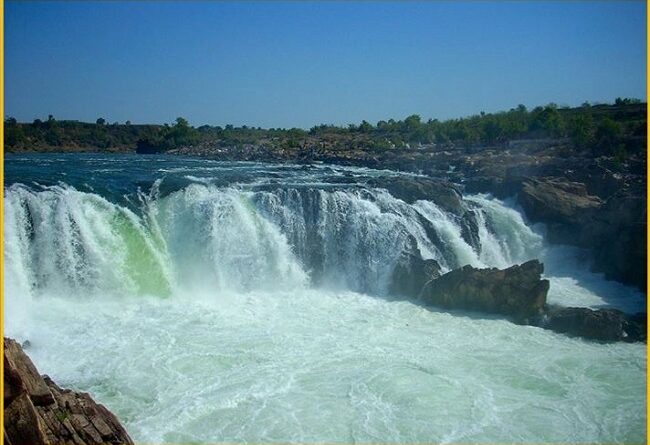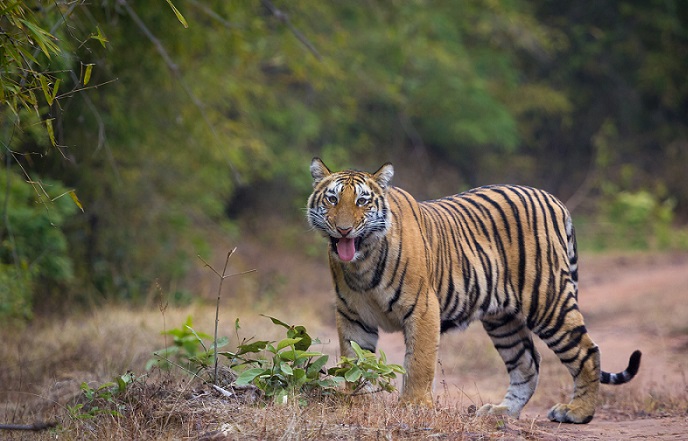Marble Rocks of Bhedaghat: Take a GeoTourism around the Geological wonder of Dhuandhar
If you are a Rocks lover then it is surprising you at Bhedaghat Waterfall. The Narmada river throws spectacular views at Bhedaghat as Dhuandhar falls which accompanied by a Marble rock to grace the river. The massive 98 ft. mountain creating natural flaunts when you sail along the river Narmada.

Away from the noise of cities, Bhedaghat situated 25 km away from Jabalpur city in Madhya Pradesh. At Bhedaghat Narmada flowing gently before makes an abrupt plunge at Dhuandhar and creating a majestic, waterfall. a gorge formed by the erosion of the river Narmada cutting through rock.
30 meters high Dhuandhar waterfalls creating a smoky look with water droplets splashing around, also popularly known as the “smoke cascade”. Just as the name suggests, (Dhuan meaning smoke and Dhar meaning flow) the flowing water of this beautiful falls gives off a smoke-like feeling. This is exactly the place where Shahrukh Khan wooed Kareena Kapoor in one of his films – Ashoka.

If you are lucky, you can also spot a rainbow across the falling water. There lies a bed of white and grey marble rocks below the water that further enhances the whitish color of the Bhedaghat waterfall.
The biggest attraction of the Bhedaghat is the hanging marble rocks. the limestone rocks crafting a magical appearance on both sides of the Narmada river. Through the boat, you can see the rocks with different shapes and colors. At one point, the cliffs on both sides come so close together that a monkey can leap from one side to the other, the place is named Bandar Kodani. There’s also a cable car that takes passengers from the eastern bank of the Narmada to the west. It offers a stunning view of the falls.

Apart from the marble rock some manmade and natural wonders are also present at the destination. One of them the magnificent 64 Yogini temple located near Bhedaghat Fall looks resplendent with carved stone sculptures. temple built-in the 10th century by the Kalchuri rulers. The circular structure is dedicated to Goddess Durga and her 64 yoginis, which considered the mother of the Universe.
Puja of the Narmada river is very common In Jabalpur. The puja takes place in Gwarighat after taking a ferry to the temple located in the middle of the river you can watch the spiritual spectacle in Bhedaghat. It is popular as a venue for Narmada Mahotsava organized on a full-moon night in Sharad Purnima festival.

Madan Mahal Fort- A major tourist attraction of Jabalpur. The fort is one of the best places to visit near Bhedaghat Waterfall. Built by the Gond rulers in the 17th century, the fort is a fine example of their grandeur. it is believed that this ancient temple is connected to the Gond Queen Durgavati’s palace through an underground passage.
Balancing Rock is another site that is a must-see for tourists. Located at the base of Madan Mahal Fort its hanging position has made it famous among tourists. An eroded volcanic rock formation that is balancing on another rock.

The best time to visit this region is from October to April as during this time climate remains pleasant and calm.
Geological history-
The southeastern plateaus of Satpura are cut across by the Narmada it’s south of Jabalpur & Deccan Trap farming flat-topped hills cover the whole area of Satpura in the southeast. The humongous limestone and magnesium rocks flank the river Narmada giving the tourists an ethereal view of the many scenic locations. magnesium limestone rocks cast different colors in different lights and are especially beautiful in the moonlight.
Bhedaghat Waterfall is a part of the Narmada River Valley which is having very old rocks from pre-historic times. On excavation, fossils were also found in this region. River Narmada is much older than the river Ganges and Himalayan ranges which enhances its importance.
ancient geology characterized by marble and limestone rocks, all lifted over eons into its present rugged relief. The white-grey of these rocks is due to the presence of a large amount of magnesium, which also lends it a soapstone-like texture.

The Marble Rocks of the Narmada gorge, appear to have a polyphase structural history. Of the three-fold phases (F1 – F3) recognized in the metamorphic rocks of the Narmada section, west-southwest of Jabalpur town, only two are distinguishable in the Bheraghat section-an early phase of tight folding on roughly easterly trending axes and a late phase of gentle folding on axes oriented transverse to the earlier fold trend.
The early and late folds are related to the second (F2) and third (F3) fold phases respectively, in the region. Basic dykes cutting the marbles of Bheraghat are shown to belong to two different ages-one highly metamorphosed and deformed and considered to be syntectonic with the early fold phase, and the other, practically unaltered and unreformed, of a post-tectonic, post-metamorphic age.
Emplacement of quartz veins associated with the marbles is shown to have begun sometime during the early fold phase, continued through the late fold phase, and outlasted it.



